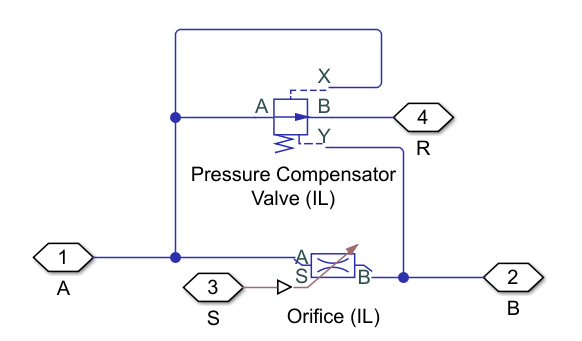Pressure-Compensated 3-Way Flow Control Valve (IL)
3-way flow control in an isothermal liquid system
Libraries:
Simscape /
Fluids /
Isothermal Liquid /
Valves & Orifices /
Flow Control Valves
Description
The Pressure-Compensated 3-Way Flow Control Valve (IL) block models constant-pressure flow control. When the control pressure, pA – pB, meets or exceeds the Set orifice pressure differential, the relief component of the underlying compensator valve opens to maintain the pressure in the block.
The flow control valve opening and closing is controlled by a physical signal received at port S, which determines the area of the underlying orifice block. A positive signal opens the valve. Port R vents liquid to another part of your network.
For pressure-compensated flow control without venting, see the Pressure-Compensated Flow Control Valve (IL) block.
Orifice Parameterization
You can choose the valve model with the Orifice parameterization setting:
Linear - area vs. control member positionis an analytical formulation that assumes the valve opening area and the valve control member are related linearly.Tabulated data - Area vs. control member positionis a user-supplied data sheet that relates orifice opening area and the control member position. The block queries between data points with linear interpolation and uses nearest extrapolation for points beyond the table boundaries.Tabulated data - Volumetric flow rate vs. control member position and pressure dropis a user-supplied data sheet that relates the control member position, orifice pressure drop, and orifice volumetric flow rate. The block queries between data points with linear interpolation and uses a nearest extrapolation for points beyond the table boundaries.
Numerically-Smoothed Area and Pressure
When the orifice parameterization is linear, you can maintain numerical robustness at the extremes of the orifice area and valve pressure range by tuning the Smoothing factor parameter to a nonzero value less than 1. If the Smoothing factor parameter is nonzero, the block applies a smoothing function to all calculated areas and pressures, but it primarily influences the simulation at the extremes of these ranges.
If you enable smoothing, the block smoothly saturates the orifice area between the Leakage area and Maximum orifice area parameters. The block smoothly saturates the valve pressure between the Set orifice pressure differential parameter and the sum of the Set orifice pressure differential and the Pressure compensator valve regulation range parameters.
For more information, see Numerical Smoothing.
Block Schematic
The Pressure-Compensated 3-Way Flow Control Valve (IL) is constructed from the Pressure Compensator Valve (IL) and Orifice (IL) blocks.
Three-Way Flow Control Valve Schematic

Examples
Ports
Conserving
Input
Parameters
Extended Capabilities
Version History
Introduced in R2020a

